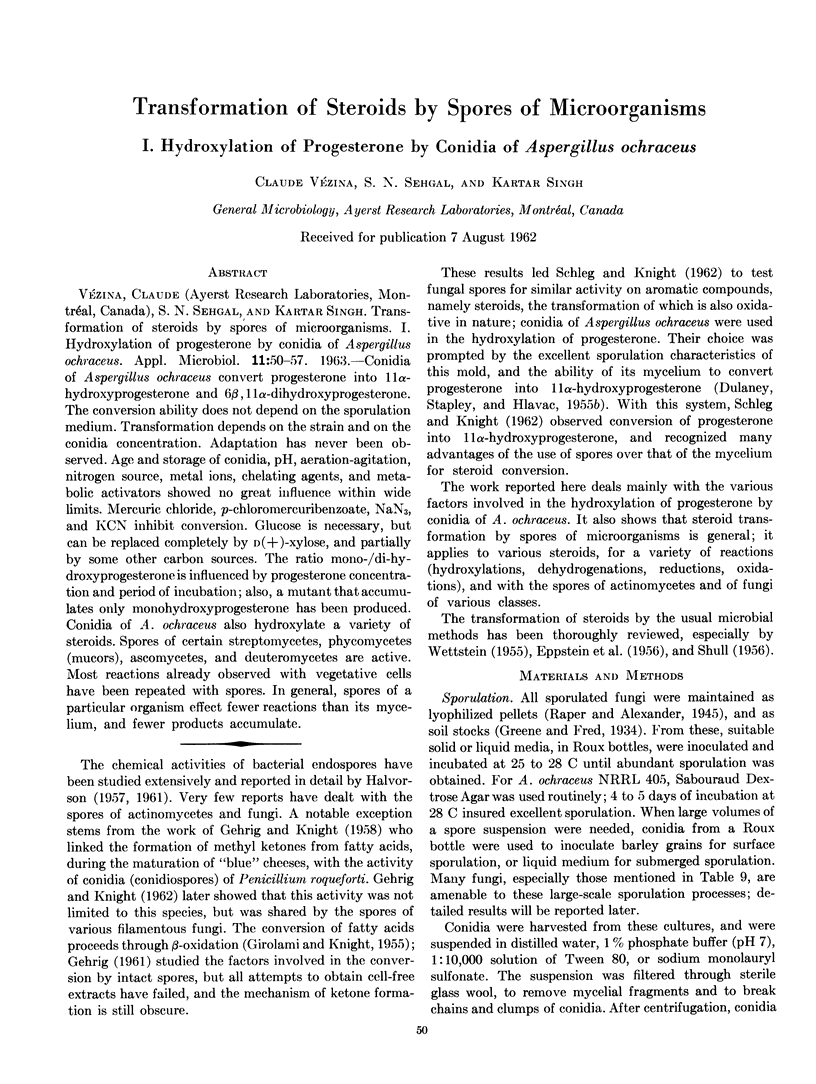Abstract
Conidia of Aspergillus ochraceus convert progesterone into 11α-hydroxyprogesterone and 6β, 11α-dihydroxyprogesterone. The conversion ability does not depend on the sporulation medium. Transformation depends on the strain and on the conidia concentration. Adaptation has never been observed. Age and storage of conidia, pH, aeration-agitation, nitrogen source, metal ions, chelating agents, and metabolic activators showed no great influence within wide limits. Mercuric chloride, p-chloromercuribenzoate, NaN3, and KCN inhibit conversion. Glucose is necessary, but can be replaced completely by d(+)-xylose, and partially by some other carbon sources. The ratio mono-/di-hydroxyprogesterone is influenced by progesterone concentration and period of incubation; also, a mutant that accumulates only monohydroxyprogesterone has been produced. Conidia of A. ochraceus also hydroxylate a variety of steroids. Spores of certain streptomycetes, phycomycetes (mucors), ascomycetes, and deuteromycetes are active. Most reactions already observed with vegetative cells have been repeated with spores. In general, spores of a particular organism effect fewer reactions than its mycelium, and fewer products accumulate.
Full text
PDF







Selected References
These references are in PubMed. This may not be the complete list of references from this article.
- BURTON R. B., ZAFFARONI, KEUTMANN E. H. Paper chromatography of steroids. II. Corticosteroids and related compounds. J Biol Chem. 1951 Feb;188(2):763–771. [PubMed] [Google Scholar]
- DULANEY E. L., MCALEER W. J., KOSLOWSKI M., STAPLEY E. O., JAGLOM J. Hydroxylation of progesterone and 11-desoxy-17-hydroxycorticosterone by Aspergillus and Penicillium. Appl Microbiol. 1955 Nov;3(6):336–340. doi: 10.1128/am.3.6.336-340.1955. [DOI] [PMC free article] [PubMed] [Google Scholar]
- EPPSTEIN S. H., MEISTER P. D., MURRAY H. C., PETERSON D. H. Microbiological transformations of steroids and their applications to the synthesis of hormones. Vitam Horm. 1956;14:359–432. doi: 10.1016/s0083-6729(08)60305-2. [DOI] [PubMed] [Google Scholar]
- GEHRIG R. F., KNIGHT S. G. Formation of ketones from fatty acids by spores of Penicillium roqueforti. Nature. 1958 Nov 1;182(4644):1237–1237. doi: 10.1038/1821237a0. [DOI] [PubMed] [Google Scholar]
- GIROLAMI R. L., KNIGHT S. G. Fatty acid oxidation by Penicillium roqueforti. Appl Microbiol. 1955 Sep;3(5):264–267. doi: 10.1128/am.3.5.264-267.1955. [DOI] [PMC free article] [PubMed] [Google Scholar]
- SHULL G. M. Transformations of steroids by molds. Trans N Y Acad Sci. 1956 Dec;19(2):147–172. doi: 10.1111/j.2164-0947.1956.tb00518.x. [DOI] [PubMed] [Google Scholar]
- VEZINA C., RAPER K. B. Presumptive heterokaryons in Aspergillus fonsecaeus. J Bacteriol. 1957 Sep;74(3):396–408. doi: 10.1128/jb.74.3.396-408.1957. [DOI] [PMC free article] [PubMed] [Google Scholar]
- WETTSTEIN A. Conversion of steroids by microorganisms. Experientia. 1955 Dec 15;11(12):465–479. doi: 10.1007/BF02166828. [DOI] [PubMed] [Google Scholar]


